WITH mice on the rampage throughout many cropping regions this season, some producers have shown renowned ‘farmer ingenuity’ by utilising existing farm equipment to make their own bait spreaders. As with all farm innovation, the following examples show how time spent in the farm workshop can produce simple, cheap options for getting the job done.
Multispreader conversion
SOUTHERN NSW grain grower, Stephen Hatty, who farms at Matong north west of Wagga Wagga, has converted a Marshall Multispread into a mouse-baiting unit by mounting a smaller, home-built hopper in the back of the spreader.
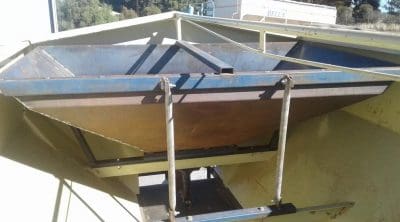
Stephen Hatty’s home-built hopper fitted inside the main hopper of his Multispreader. Click on images for a larger view.
The outlet at the bottom of the hopper has a narrow , sliding door for metering out the bait onto the spreader belt.
“It simulates how the Multispreader already works, except the slide door is only 50mm wide instead of the spreader’s standard 750mm door. We are using the belt to feed the material out with a slide door to adjust the rate,” he said.
The machine spreads bait to a width of 36 metres travelling at 25 to 28 kilometres/hour.
“There is a little bit of bait going out around in this area, but far south western NSW, western Victoria and South Australia are coping it a lot worse than we are,” Mr Hatty said.
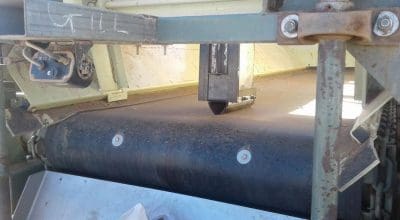
A sliding door fitted to the feed-out chute from the hopper controls the rate of bait feeding out onto the spreader belt.
“I have very fresh memories from 2012 when we had a lot of issues with mice that year, so I am taking precautions this year to make sure we get on top of them the best we can.”
Mr Hatty has baited his recently-sown canola and lentil crops and this week did a run through his peas.
Simple drum innovation
NORTHERN Victoria farmer, Brad Plant, who farms with his family near Manangatang, has built a simple, cheap mouse baiter from a 44 gallon drum, second-hand piping and some old wood drill bits.
Mr Plant has fitted a cone into the bottom of the drum, which is an old mouse bait drum from the previous time he baited back in 2011.
The metering mechanism is a bit of pipe that acts like the barrel on an auger. Inside that he uses an old wooden drill bit as the auger sliding screw. The bit would have originally been used for drilling holes in pine posts for fencing.
The home-built bait spreader is fitted to the farm’s ground-drive seeder and uses the seeders’ drive to meter out the bait.
“There was a shaft nearby that was turning relative to ground speed. We put a couple of universals onto that to connect it to the drill bit. The drill bit is held by a keyless chuck so we can change the size of the drill bit to change the rate,” he said.
“We had to fine tune it a bit by grinding down the drill bits to get them to the right rate. At the start there were a lot of adjustments, but once we got it right we left it alone.”
It has been a big year for mice at Manangatang, forcing the Plants to bait all their cereal stubbles. The barley was the worst.
Whale tail of an idea
RIVERINA farmer, Michael Pfitzner, who runs a dryland cropping enterprise north of Griffith, has transformed a whale tail into a handy mouse baiting unit.
“We had a whale tail on the back of the air cart and made a manifold so we could either utilise the small seed box or canola roller in the main box for putting mouse bait out,” he said.
“With the canola we could just put it out with the canola roller in the main box or use the small seeds box when we are using the other bins. It delivers mouse bait at the correct rate.”
Mr Pfitzner said a lot of the cereal stubbles had significant mouse populations this year, especially on the lighter soil types.
“We baited everything at sowing time, except for any chemical fallow or anywhere there weren’t any mice,” he said.
“We will probably still have to apply some bait to control some of the high-density patches where there are still mice. They should taper off in June/July.
“I think they were only causing an issue with some of the crop that was up where they were just trying to get some moisture. They were chewing on lupins just to get the moisture out of them.”

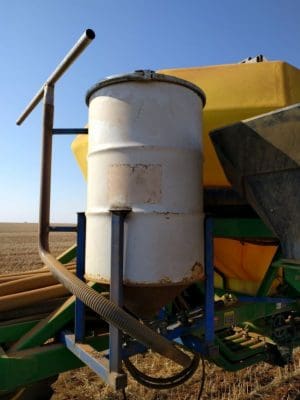
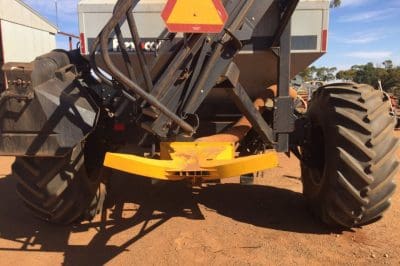
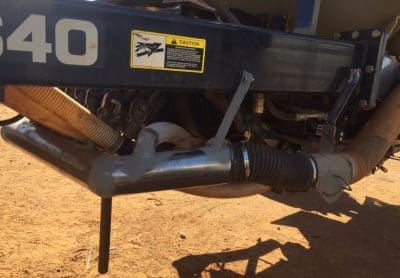


HAVE YOUR SAY